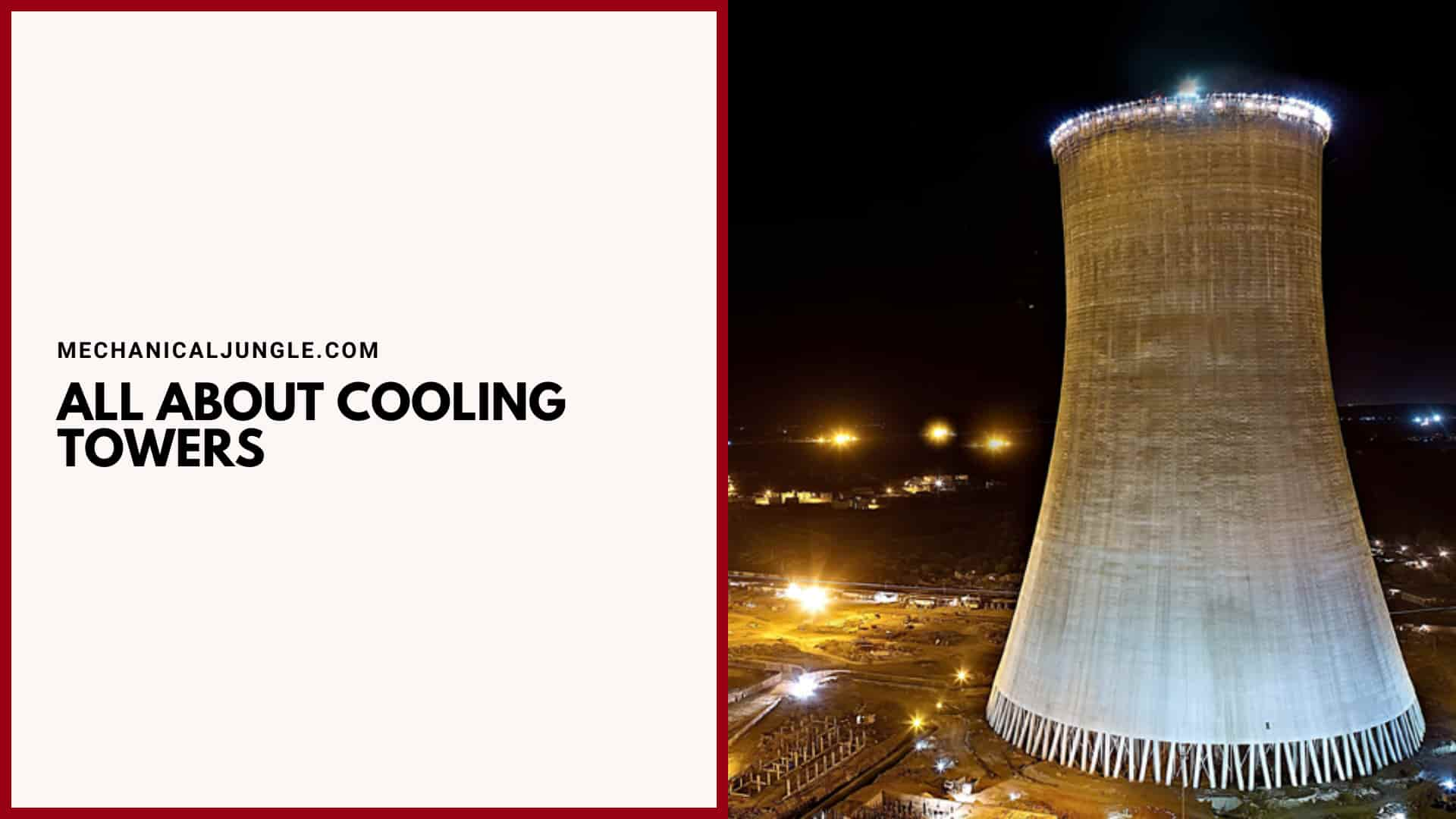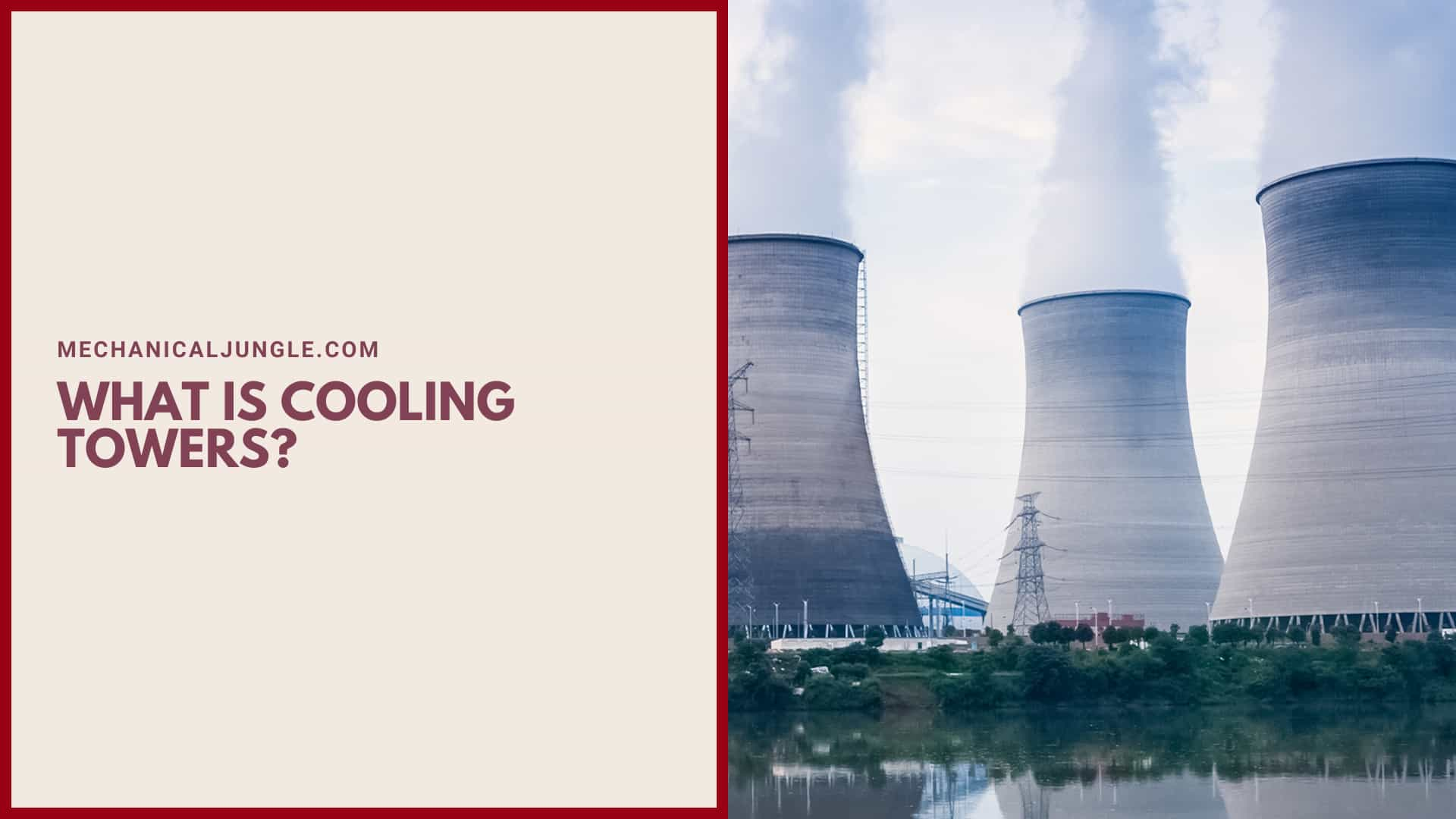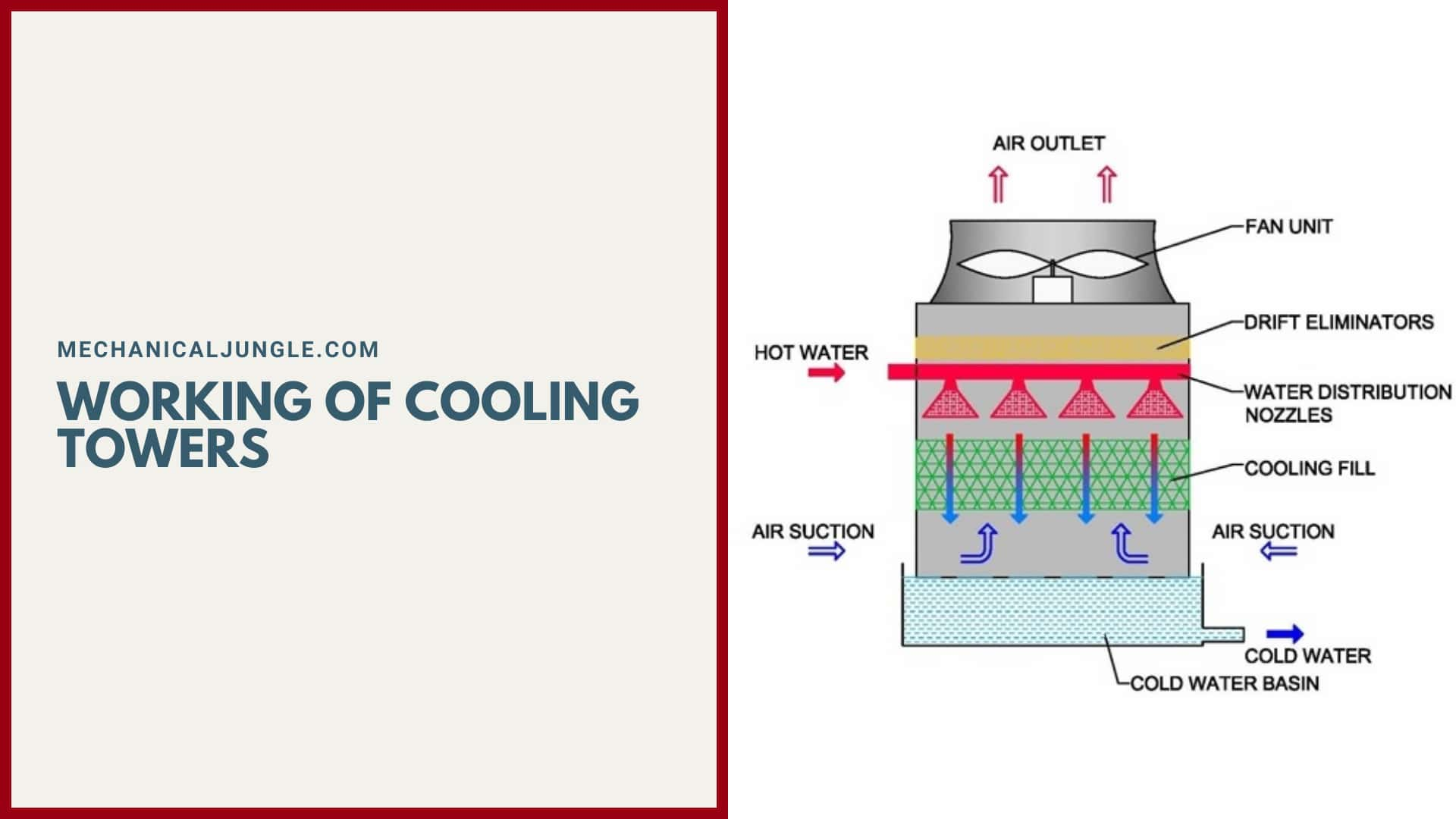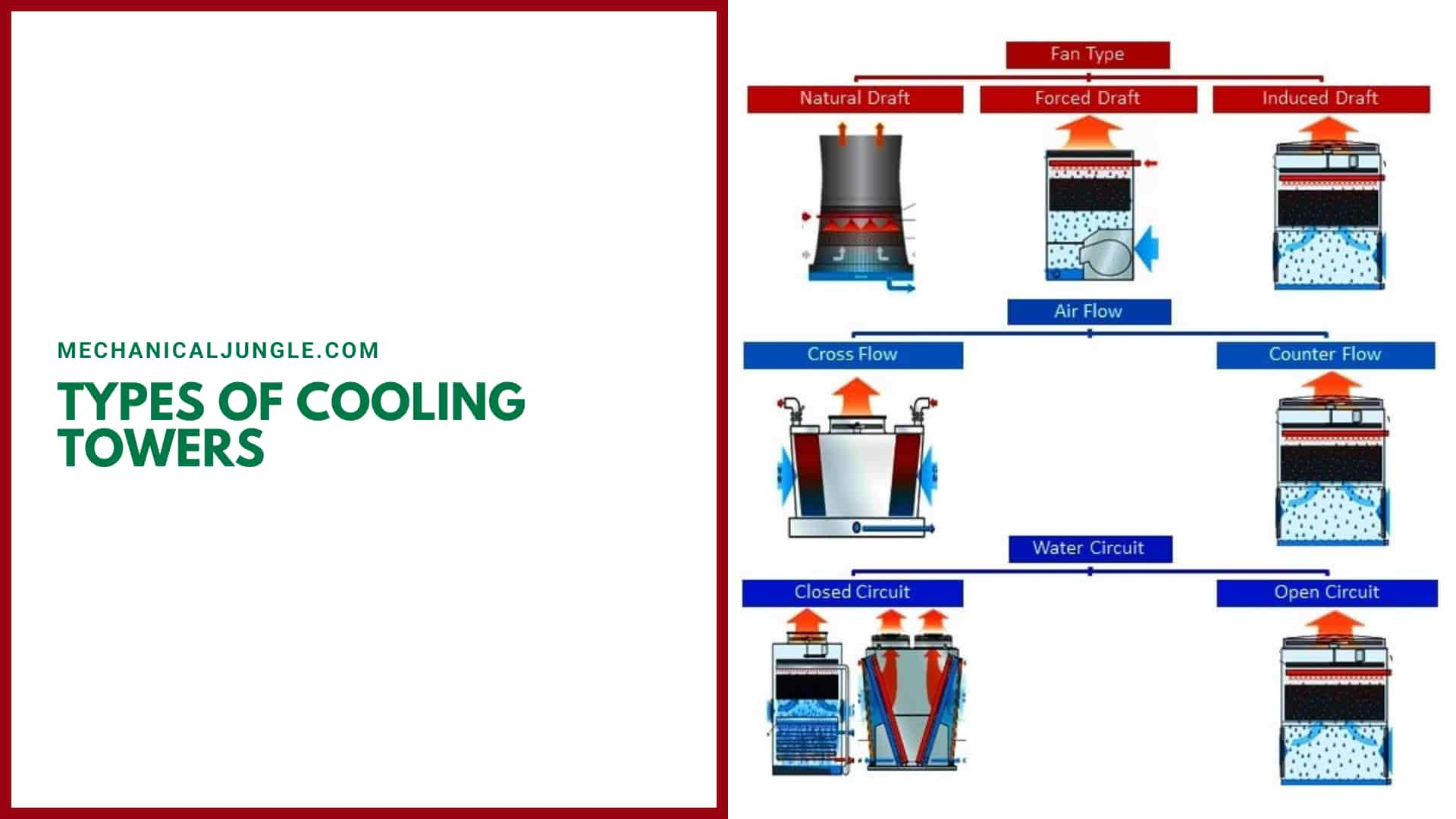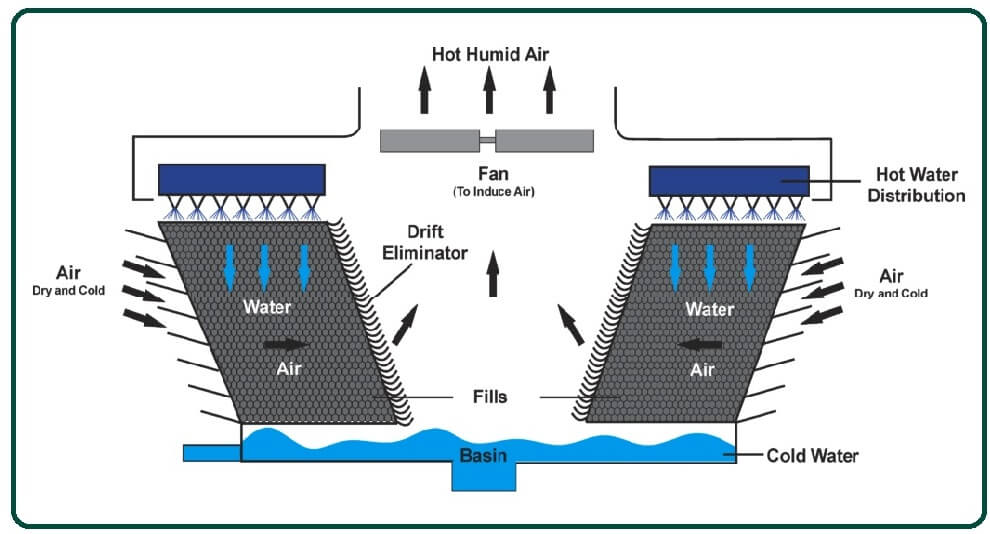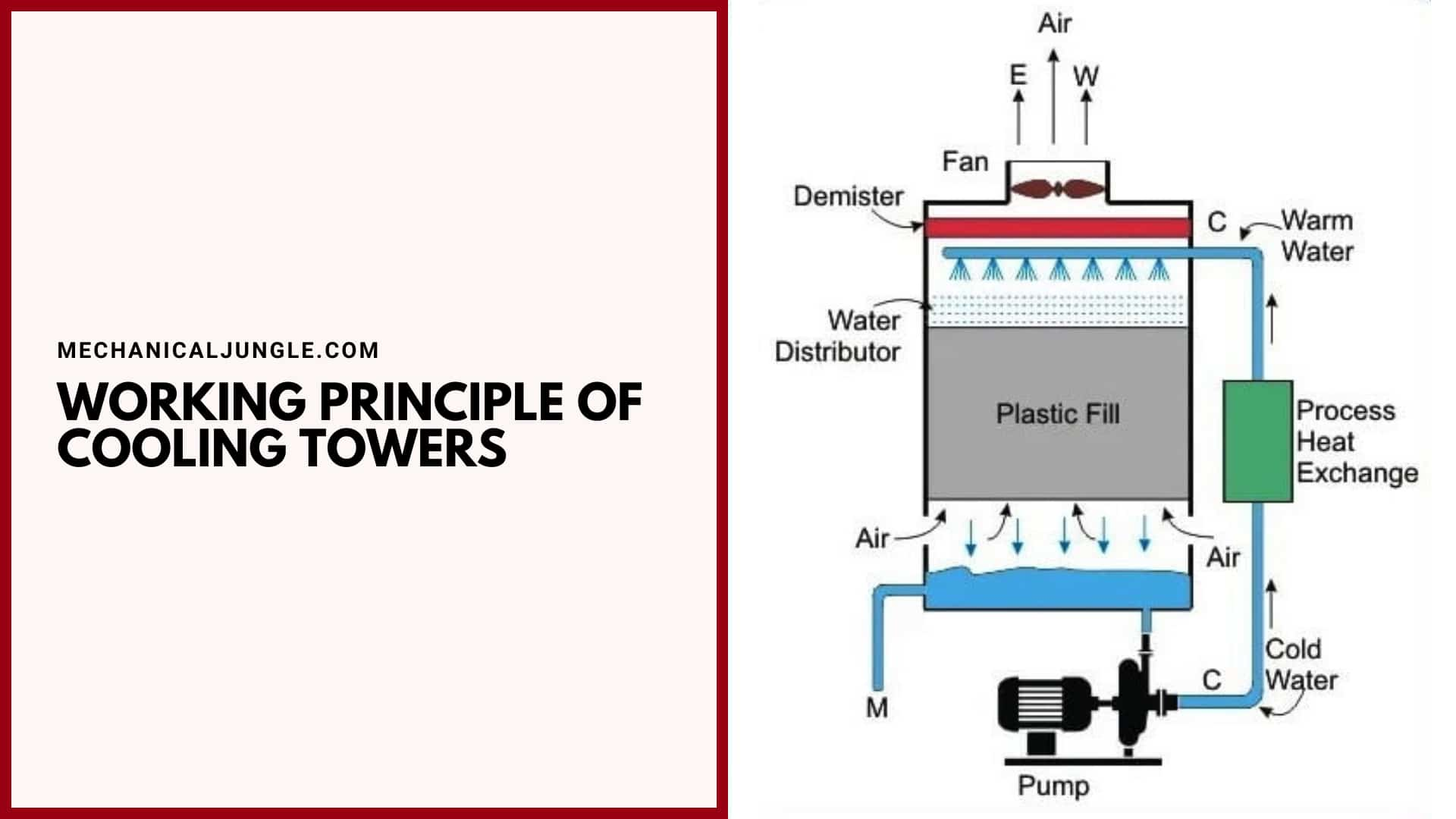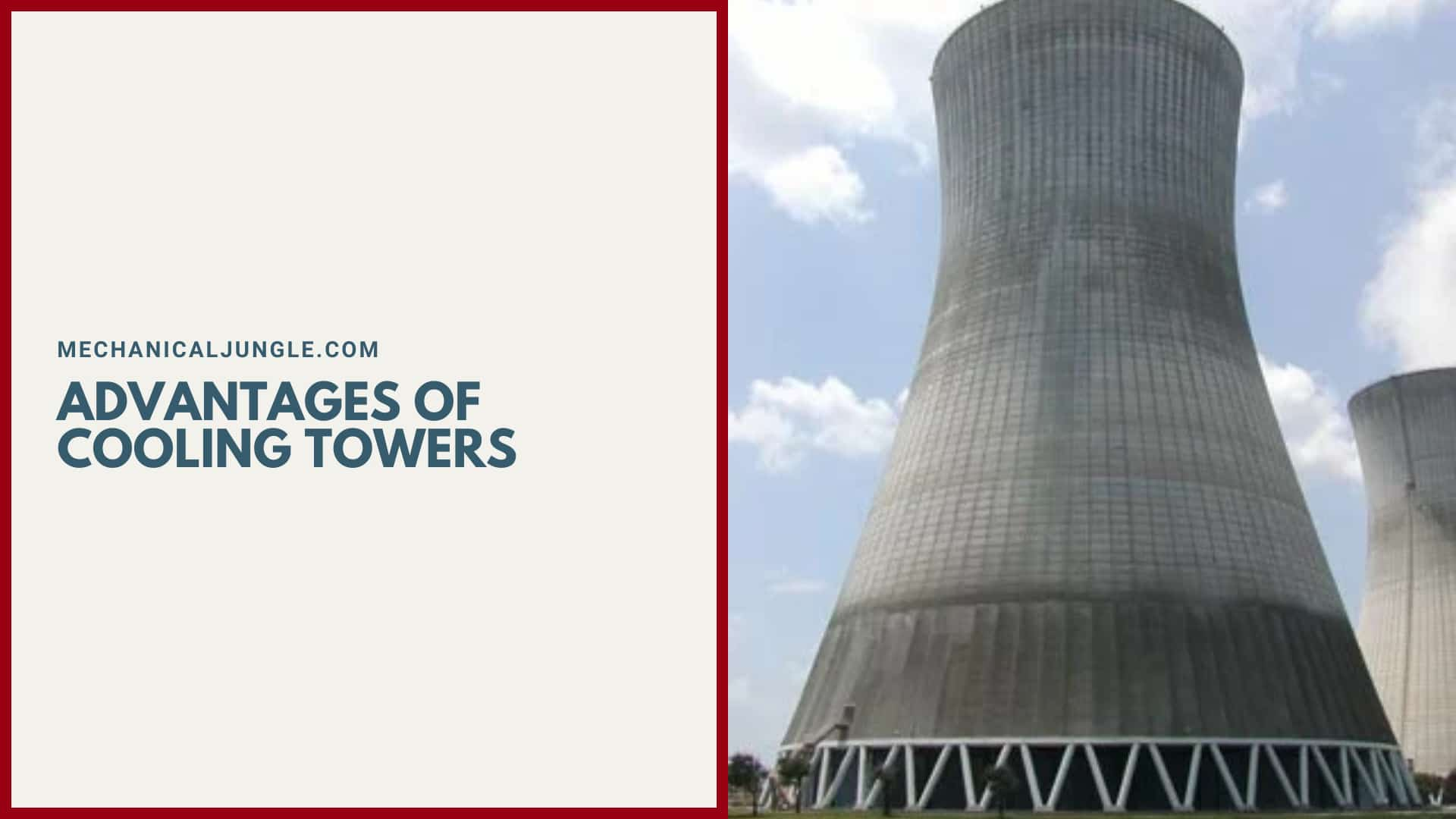Important Point
What Is Cooling Towers?
Water, which has been heated by an industrials process or an air conditioning condenser, is pumped through the pipe into the cooling tower.
Water circulates through nozzles on the coast of a material called “fill,” which slows down the flow of water through the cooling tower & exposes as much water surface area as possibles for maximum air-to-water contact.
As the waters flow through the cooling tower, it is exposed to air, which is being pulled through the tower by an electric motor-driven fan.
When water and air meet, a small amount of water evaporates, leading to a cooling action.
The cooling waters are then pumped back into the condensers or process types of equipment, where it absorbs heat. It will then be pumped backs to the cooling towers once again to cool.
Cooling Towers Fundamentals provides a level of basic cooling tower knowledge and is a great resource for those wanting to learn more.
Industrial cooling towers are an effective way of transporting unwanted heat from one place to another using water, where transport media is used in applications where cold water is in the temperature range of 70 ° F to 100 ° F. Must be a reliable source.
Cooling towers are commonly used for cool products, including injection molding, tools and die-cutting, food and beverage, chemicals, lasers, machine tools, semiconductors, and more in a multitude of applications.
While there are different manufacturers using different designs, all cooling towers operate using the same principle of evaporative cooling.
Working of Cooling Towers:
Hot water from power plants or industries circulates on the fils (heat exchanging surface) through nozzles connected to hot water pipes.
Fills have a hexagonal cavity over them that allows the diffusing water to slowly move down. And the air from the bottom of the cooling tower moves upwards and fills.
When air and hot water come in contact with each other, air takes latent heat from the water and cools it.
The air takes heat from the water, so it becomes hot, and due to this, it evaporates some water and cools the water further.
As we all know that evaporation gives a cooling effect, i.e., where evaporation occurs on the surfaces from which evaporation is cooling.
After cooling the hot water, the air moves upward with evaporated water.
Above the hot water pipe, we have a drift eliminator. The drift eliminator cools most of the water vapor and prevents it from escaping from the cooling tower.
Some water vapor that is too low may escape. The hot air finishes the flow and escapes from the cooling tower.
Some of you may wonder why thises is going to end the drift, so I will tell you so this remover is reducing the water loss from the cooling tower.
As the water is filled, it gets colder and colder, and finally, it gets collected in the basin.
And from the basin, the cooling water is circulated to the condenser of the power plant and industrial machinery for the purposes of re-cooling.
The circulation of water inside and outside the cooling tower is done using centrifugal pumps.
Also, Read: How Does a Radiator Work? | Parts of Radiator | Coolant In The Radiator | Radiator Failure
Types of Cooling Towers:
Cooling tower systems are often important for industrial processes. These elongated, open-ended, cylindrical structures are responsible for the cooling water generated by industrial or HVAC comfort cooling airflows.
They are classified by the types of the draft (natural or mechanical) and the direction of airflow (counter or cross).
#1. Natural Draught Cooling Tower
In this type of cooling tower, the fan is not used to circulate air, but here, it is used to enclose the hot air in the chimney, and this will cause the hot air and the surrounding air.
A pressure difference will arise. These pressure differences cause air to enter the cooling tower.
This requires a larger hyperbolic tower, so capital costs are higher, but operating costs are lower in the absence of an electric fan.
There are two types of natural draft cooling towers, rectangular wooden towers S and reinforced concrete hyperbolic towers.
#2. Forced Draught Cooling Tower
In such a cooling tower, the fan is used to circulate air. When a power plant operates at peak load, it requires a large amount of cold water.
To rotate the fan, it uses a motor with a speed of about 1000 rpm. The working principle is similar to the natural draft cooling tower, the only difference being that the fan is placed on the cooling tower here.
If the fan is mounted on the top of the tower, an induced draft is called the cooling tower, which is most popular for installation of very large capacity and requires a large capacity of the fan.
So, the forced draft cooling tower has a horizontal shaft for the fan and is placed under the tower, and the induced draft cooling tower has a vertical shaft and is placed on top of the cooling tower.
#3. Mechanical Draft Cooling Tower
Air is forced through the structure by the fan, which transmits air through the tower. Common fans used in these towers include propeller fans and centrifugal fans.
While mechanical draft towers are more effective than natural draft towers, as a result, they consume more power and cost.
#4. Crossflow Cooling Tower
There is a design that allows air to flow horizontally through the filler and tower structure into an open plenum area.
Hot water flows downstream from the distribution basins. However, fans and motor drives require weather-proofing against moisture, which can make freezing less efficient.
#5. Counterflow Cooling Tower
There is a design where the air moves upward and comes counter-current with a hot spring to cool the air.
This allows maximum performance from each planning area and helps reduce pump requirements.
In addition, counterflow cooling tower systems are less likely to freeze ice in cold weather and save energy in the long run. All Delta cooling towers retract from these advantages.
#6. Inspired Draft Cooling Tower
They are usually placed on top of a cooling tower with a fan, which vents hot air and draws out the entire air.
Higher exit air velocities reduce the probability of re-circulation. Discarding stream In order to avoid the entry of water droplets into the air, the flow eliminator is used.
Driven draft towers are more efficient because they use 30% to 75% less energy than forced draft designs.
Also, Read: How Do Drum Brakes Work? | Working of Drum Brakes | Type of Drum Brakes
Working Principle of Cooling Towers:
The basic working principle of cooling towers is to cool the hot water with the help of atmospheric air.
However, it is widely used in various engineering fields and other refrigeration plants. The height of the cooling tower in the thermal power plant is about 9 feet or more from the ground.
A water shop unit called Talab is placed at the base of the cooling tower. In a steam power plant, the cooling tower first collects hot water from the condenser at a certain height from the ground level; then, the hot water falls down by radial spray.
Atmospheric air that is relatively quiet enters the lower part of the tower. Now the hot air in the cooling towers exposes atmospheric air, which reduces the temperature of the hot water by partial evaporation.
This cold water is collected in the pond at the base of the tower and pumped into the condenser for further use. Cooling towers operate on the principles of evaporative cooling.
When the air comes in contact with hot water, it takes away the latent heat of the water and cools it.
Also, after taking heat from hot water, the air temperature rises, and it evaporates some of the water, and it cools water to a lower temperature.
Advantages of Cooling Towers:
Here, the different advantages of cooling towers are as follows
- Compared to natural draft cooling towers, they are more effective.
- These towers have higher cooling rates.
- These towers are smaller in size than natural draft towers.
Frequently Asked Questions (FAQ)
Types of Cooling Towers
There are three main types of cooling towers that are defined by how water or air passes through them. These types include crossflow, counterflow, and hyperbolic. There are also two varieties classified solely on airflow, known as induced draft and passive draft cooling towers.
Cooling Tower Working
Cooling tower systems work by using water to extract waste heat from a system and ejecting it into the atmosphere primarily through evaporation. The three key components of a cooling system are the cooling tower, recirculating pump, and heat exchanger. Water first passes through a heat exchanger where it absorbs heat.
Mechanical Draft Cooling Towers
Induced draft towers have a large propeller fan at the top of the tower (discharge end) to draw air upward through the tower while warm condenser water spills down.
How Cooling Tower Works
The working principle of the cooling tower is quite impressive. Cooling in the cooling towers is caused by partial evaporation of water and heat exchange with air. The water in the cooling tower flows over the droplet, flowing with droplets or a thin layer. Thus, air flows through the channels.
What Are Cooling Towers Used For?
Cooling towers are primarily used for heating, ventilation, air conditioning (HVAC), and industrial purposes. Cooling towers provide a cost-effective and energy-efficient operation of systems in need of cooling. More than 1,500 industrial facilities use large quantities of water to cool their plants 2.
What Is Cooling Tower?
A cooling tower is a specialized heat exchanger in which air and water are brought into direct contact with each other in order to reduce the water’s temperature.
Cross Flow Cooling Tower
In a crossflow cooling tower, the process water is pumped to the top of the tower into the hot water distribution basin. The distribution basin is out of the way of the airstream and is gravity fed. The only driving force behind the nozzles is the hydrostatic head of water above the nozzle itself.
Types of Cooling Towers and Their Applications
There are three main types of cooling towers that are defined by how water or air pass through them. These types include crossflow, counterflow, and hyperbolic. There are also two varieties classified solely on airflow, known as induced draft and passive draft cooling towers.
Cooling Tower Efficiency and Maintenance Tips
- Perform a detailed inspection of the entire cooling tower system, including mechanical and electrical components.
- check fan blades for cracks, balance and alignment.
- weigh selected fill blocks from lower levels & record weights to measure fouling.
- Inspect and clean water basins and sumps.
Top-rated cooling tower manufacturers in the USA
- Cooling Tower Systems, Inc. Macon, GA | 800-752-1905. Our circular FRP (fiberglass reinforced polyester) cooling towers are second to none.
- Robson Industries. West Chester, PA | 888-567-8308.
- Aggreko. Houston, TX | 833-507-6345.
- Cold Shot Chillers. Houston, TX | 800-473-9178.
Cooling Tower Water Treatment for Optimal Performance
An effective water treatment program for cooling towers involves several key steps:
- Water Quality Analysis: Start by analyzing the incoming water source to understand its composition, hardness, pH, alkalinity, and other relevant parameters. This analysis helps determine the appropriate treatment chemicals and strategies needed.
- Scale and Corrosion Inhibition: Scaling occurs when minerals in the water precipitate and form deposits on heat transfer surfaces. Corrosion can damage equipment and lead to leaks. Use scale and corrosion inhibitors to prevent these issues. These inhibitors form a protective layer on surfaces to prevent the buildup of deposits and corrosion.
- pH Control: Maintaining the proper pH level is essential to prevent corrosion and scale formation. Cooling water pH should typically be maintained within a range of 7.0 to 8.5. Chemicals like pH adjusters (acid or alkaline) can be used to maintain the desired pH level.
- Biological Control: Cooling towers provide an ideal environment for the growth of algae, bacteria, and other microorganisms. These can cause fouling, corrosion, and even health risks. Biocides (chemicals that control biological growth) should be used to prevent microbial growth. Regular monitoring and adjustment of biocide levels are important to ensure effectiveness.
- Filtration and Sediment Removal: Install appropriate filters to remove suspended particles from the cooling water. This helps reduce fouling and enhances heat transfer efficiency.
Cooling Tower Technology Advancements for Energy Savings
However, crossflow designs of modern, factory-assembled cooling towers permit “variable flow” operation, which reduces water flow rate and energy consumption during cooler months. This ensures energy is only expended for cooling when the plant truly needs it, maximizing efficiency.
Classification of Cooling Tower
Because the process fluid is in a closed loop, fluids other than water and fluids at much higher temperatures can be cooled. There are three primary ways to classify a cooling tower — manufacture type, draft type, and air/water contact.
Cooling Tower Principle
Cooling towers use this same principle of evaporative cooling to cool a continuous flow of water. Cooling towers are essentially large boxes designed to maximize evaporation of water. To do this, they contain material, typically PVC plastic sheets, that create large surface areas for water evaporation to occur.
How Cooling Towers Work?
Air enters the tower beneath the fill and is drawn up vertically into the tower. Above the fill, hot water is introduced through low pressure spray nozzles to divide the hot water over the surface of the fill in fine droplets. The cooling air draws heat from the water as it progresses to the bottom of the tower.
Natural Draft Cooling Tower Working Principle
The natural draft cooling tower is an open, direct-contact system. It works using a heat exchanger, allowing hot water from the system to be cooled through direct contact with fresh air. To increase the heat transfer surface area (and optimize the cooling process), hot water is sprayed from nozzles within the tower.
What Is a Cooling Tower Used For?
A cooling tower is designed to remove heat from a building or facility by spraying water down through the tower to exchange heat into the inside of the building. Air comes in from the sides of the tower and passes through the falling water.
What Is Cooling Tower and How It Works?
A cooling tower is a specialized heat exchanger in which air and water are brought into direct contact with each other in order to reduce the water’s temperature. As this occurs, a small volume of water is evaporated, reducing the temperature of the water being circulated through the tower.
What Comes Out of Cooling Towers?
Yet despite the familiarity we have with them, knowledge about what a cooling tower actually does remains limited. A common misconception is that they release pollution. In fact, what they actually release is water vapour – similar to, but nowhere near as hot, as the steam coming out of your kettle every morning.
Like this post? Share it with your friends!
Suggested Read –
- Types of Dial
- Planning Machine
- Chemical Milling
- Cutting Coolant Fluid
- Is Ford Maverick Electric
- How to Change Oil in Truck
- How Do Drum Brakes Work
- Angle Plate for Milling Machine
- Different Types of Cooling Tower
- 13 Different Types of Milling Cutters
- Centrifugal Pump Working Principle
- Domestic Electrolux Refrigerator | Different Components of Domestic Electrolux Refrigerator
- Types of Angle Plates | Box Angle Plate of Angle Plate | Swivel Angle Plates of Angle Plate | Cast Iron T-Slotted Angle Plate of Angle Plate
- What Is Wilson-Hartnell Governor? | Wilson Hartnell Governor | Construction of Wilson Hartnell Governor | Working of Wilson Hartnell Governor
- Cochran Boiler | Cochran Boiler Working | Working Principle of Cochran Boiler | Applications of Cochran Boiler | Advantages & Disadvantages of Cochran Boiler
- What Is Cupola Furnace? | Cupola Furnace Design । Cupola Construction | Purpose of Cupola | Working Principle of Cupola Furnace: | Advantages of Cupola Furnace | Disadvantages of Cupola Furnace | Applications of Cupola Furnace
